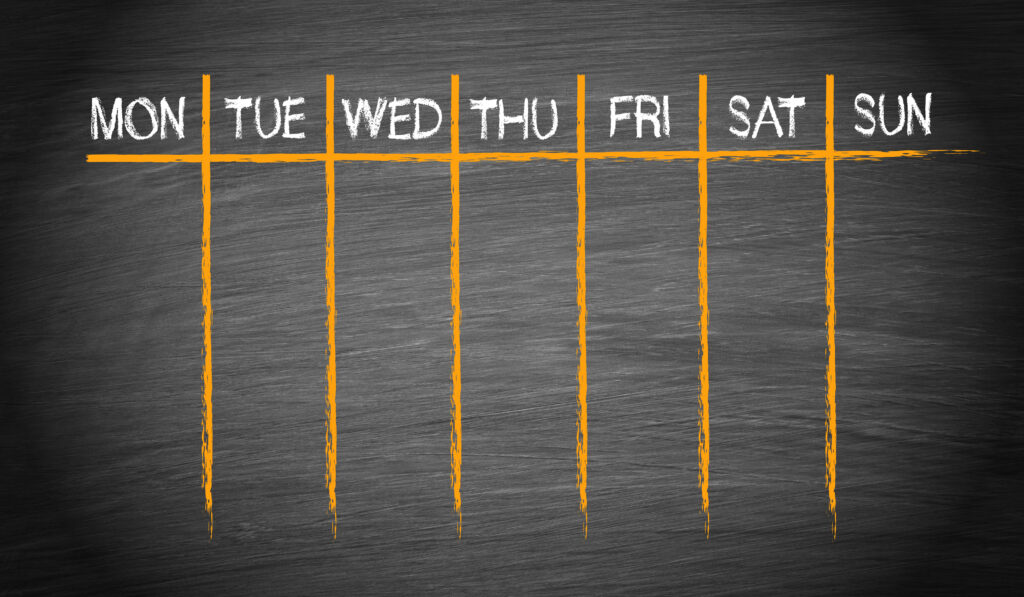Introduction
Welcome to the final installment of the Writing your own Program series! If you haven’t perused the other pieces of this series, check them out here, here, and here so that we’re all on the same page by the time you get around to this one.
In this particular piece, we’re going to touch on some clues for designing a long-term program. In previous parts of this series, we’ve primarily focused on acute training variables for designing individual workouts. In this last chunk, we’re going to go over the planning component of a training program. Unfortunately, we’re going to have to use some super generic programming terms, like microcycles and mesocycles, to discuss this in detail. Typically, these are phrases or words uttered by folks who have no idea what they’re talking about, but we do need to introduce them to get you thinking about the long-term.
Let’s get started.
Long-Term Planning
All the way back in Part 1 of this series (here) we discussed goal setting. Undoubtedly, if you’ve been reading this series, you probably have pretty big training goals. Some of you might even want to grace the bodybuilding stage or powerlifting platform someday. That’s great! However, you need to always think about the long-term when it comes to training. Dave Tate, a professional powerlifter and founder of EliteFTS, is often quoted as saying:
“What do you need to do today to get to where you want to be in 5-years?”
Stop. Re-read that. Think about it for a second. So many people are in a hurry to build slabs of muscle or add plates to their bench. Have you ever thought about how long it’s actually going to take to do that? Have you ever considered that a rest day or deload week is what you need to do right now to get to that long-term 5-year goal?
When we talk about long-term planning, we’re starting to shift our focus from the outcome of the training program to the process. This is a common motivational phrase:
You know your goal (outcome), and you’ve been identifying components of the process (acute training variables). Now it’s time to put them together. But! Keep your focus on the process; if you’re constantly comparing your now to your goal, you’re going to be perpetually disappointed. Take each day as a small step and do what you need to do now to support that long-term goal.
With that out of the way (but hopefully still in the back of your mind), let’s get into the basic textbook terms.
Microcycle: This is typically a week of training; we’ve been hinting at how to design training weeks in previous pieces, and we’ll touch on that more here.
Mesocycle: This is a bunch of microcycles – usually about 4-12 microcycles (weeks) that comprise an entire training “block.” This is probably the length of time you’d use to support a short-term goal (e.g., gain 5-lbs of muscle, add 25-lbs to your squat, etc.). Keep in mind that 4-12 weeks isn’t a rule which is why it’s such a wide range. Use whatever timeline you need to support your current training goal.
Macrocycle: This one is a bit murkier as it needs to be within context. This could be a given season for an athlete (offseason, competition season, etc.), some consider it to be a year of training, and others might even align this with the Olympic calendar (one MAJOR competition every 4-years with smaller ones throughout). A macrocycle could constitute your long-term training goal, but I’m not a big proponent of trying to plan training out beyond ~3-6-months or so. There’s too much that can happen in the interim that might require an audible in the gym.
Microcycle (A Week of Training)
 Now, onto further detail. The single week of training is an extremely important component of a program because each week adds up to your ultimate goal. We typically use the training week to plan most of our acute training variable changes. What’s the common bro-term for the microcycle? A training split!
Now, onto further detail. The single week of training is an extremely important component of a program because each week adds up to your ultimate goal. We typically use the training week to plan most of our acute training variable changes. What’s the common bro-term for the microcycle? A training split!
Now, when it comes to strength sports like bodybuilding and powerlifting, there are a lot of options for a weekly training split. Some people promote push-pull-legs, some prefer bro splits, and others might gravitate towards a full body split. There’s not necessarily a right or wrong split – as long as it supports your goals, it’s the right one for you! Rather than going into the pros and cons of all of the different training splits (like The MusclePhD Academy does), we’re going to touch on a few factors that most folks will want out of their training split:
- A training split for bodybuilders and powerlifters should train the major muscles groups at least twice per week. Going beyond twice per week might be beneficial for some muscle groups and not others – check our article on Training Frequency here for more info there. However, unless you’re a beginner, you’ll probably want to hit the major muscle groups more than once per week.
- A training split should also allow at least 48-hours of recovery between repeating the same muscle group or movement. Keep in mind that we grow and get stronger outside the gym; we need a recovery period in order for your training to produce results. If your split has you hammering the same muscles and movements day-in and day-out, it’s probably not optimal for growth or strength gains.
- In a perfect world, a training split will schedule your most demanding workouts towards the beginning of the week or after rest days. This ensures that you’re mentally and physically fresh for these workouts. Again, this is dependent on your goals. Most people would probably agree that leg workouts are more demanding than upper body workouts, but what if your back is lagging and needs to grow more than your chest or legs? Place back workouts after your rest days! I spent an entire year focusing on my quads and I placed a rest day before and after every leg day so I could always be fresh for the workout and have additional recovery time afterwards. I had a very open schedule, so I was able to have an inconsistent weekly plan. Something to think about when it comes to planning each week!
Mesocycle (4-12 Microcycles)
Like we previously mentioned, a mesocycle is a “chunk” of microcycles that, generally, lasts about 4-12 weeks. Again, this time period is primarily due to the weight of strength training research (good pun, right?) being constrained by collegiate calendars. However, this appears to be a pretty good amount of time to dedicate to one, or a few, training goals before moving to the next. The rotation of mesocycles is, essentially, the basis of periodization.
What does that mean? Well, every 4-12 weeks or so, it would probably be a good idea to change up your training a little bit. In traditional periodization, this usually involves moving from physical skill to physical skill in a linear fashion:
GPP -> Endurance -> Hypertrophy (Strength-Endurance) -> Strength -> Power -> Competition
The length in each phase obviously depends on the skill level of the athlete (or bodybuilder), the sport/competition schedule, and the overall training goal. Since many of these phases aren’t particularly relevant to bodybuilders, read our Periodization in Bodybuilding article here for a full discussion on this topic.
Regardless, I find it useful to focus on 1-3 complementary training goals for each mesocycle. Let’s say your three goals are:
- Gain 5-lbs of muscle in 12-weeks.
- Add 25-lbs to your squat in 12-weeks.
- Add 10-15lbs to your bench in 12-weeks.
These goals complement one another; they can be performed at the same time and will likely support one another. This is where it’s important to not come up with competing goals like:
- Gain 5-lbs of muscle in 12-weeks
- Add 25-lbs to your squat in 12-weeks
- Drop your running mile time by 60-seconds in 12-weeks.
These are not complementary goals and will likely interfere with one another. If you have a long-term goal of improving your mile time in accordance with getting stronger, you can maintain your endurance during a strength mesocycle, then maintain strength during an endurance mesocycle. Shifting the focus/emphasis of each mesocycle is incredibly important to continue progressing multiple physical skills, but you need to make sure you’re maintaining other skills as you go along. This is the main harbinger of block periodization which we discuss more in our Periodization in Bodybuilding article here. Just click the link, it’s worth the read, I promise.
Changing the emphasis of each mesocycle, or block, is an important component of long-term planning for sport athletes who need to express multiple physical skills on game day. If you’re a powerlifter or bodybuilder, be thankful that you don’t have to worry about being everything (strong, conditioned, and powerful) at once. Therefore, bodybuilders and powerlifters can shift the emphasis of each mesocycle to more relevant items, like muscle groups or movements. Maybe you maintain a handful of muscle groups and emphasize 1-3 muscle groups over a mesocycle? Or you maintain your bench press but emphasize your squat and deadlift for a mesocycle? These are the things you need to start thinking about as you design a long-term training plan.
You can also diminish the mesocycle time range and consider large and small mesocycles. In this case, a “large” mesocycle is a 12-week block comprised of three 4-week small mesocycles. This is a common practice in strength sports where it will take an experienced athlete 12-weeks to achieve a goal, but they’ll need more variation in the interim. Every 4-weeks they might swap out exercises/movements but keep working towards the same goal.
Again, mesocycle design always depends on your goals. Don’t ever lock yourself into a rule book – instead, bend the rules to your favor!
Macrocycle
 This is a tougher cookie to crumble because this is where a training program gets incredibly individualized. Are you a competitive athlete? Do you compete in a strength sport? Do you compete in a physique sport? If you answered yes to any of those questions, your macrocycle would likely look much different from the casual gym bro’s.
This is a tougher cookie to crumble because this is where a training program gets incredibly individualized. Are you a competitive athlete? Do you compete in a strength sport? Do you compete in a physique sport? If you answered yes to any of those questions, your macrocycle would likely look much different from the casual gym bro’s.
In short, your macrocycle is going to be designed around your competitions. If you know you’re 6-months out from a competition, you might want to plan backwards to your current day. Keep a loose plan in mind, of course, as little things can always throw a wrench in your training wheel. However, if you know you’re doing a powerlifting meet in December, it might be a good idea to start planning out your next few mesocycles around June. Your last mesocycle (~2-3-months out) should be pretty specific to that competition; hopefully you’ve spent the previous few cycles building up your base and improving your weaknesses so you can truly conquer the platform.
If you’re a bodybuilder with a show coming in December, you should definitely start thinking about your plan around June – especially if you’ve had an, ahem, healthy bulking season. Not only do you need to consider training needs, but you’re also looking at dealing with an increasingly strict diet about 3-4 months from competition time. That will influence your training in that phase, so make sure you’re considering everything once you start to look down the barrel of your upcoming competitions.
If you’re a sport athlete, you should get your hands on your sport calendar as soon as possible. Identify the times where you want to perform well (competitive season) and areas where you want to perform your best (playoffs or championships). These are the “peaks” of your program where you’ll want to ensure you’re maximally expressing the appropriate physical skills at the right time.
Looking from the perspective of the macrocycle, it’s easy for strength athletes and normal athletes to see how their competition schedule impacts training. For powerlifters and bodybuilders, this is why it’s important to look a year ahead for potential competitions. Is it a good idea to try to do 4-5 meets/shows in a single year? Can your training support that? For most folks, probably not. Plan out 2-3 meets/shows at most and try to space them out so you can get in a mesocycle or two between each meet/show. What’s the point of competing if you never have time to improve?
If you’re not a competitive athlete/strength athlete, I still think it’s important to consider the macrocycle as a moment of reflection. It’s probably a good idea to keep a training journal, and the end of a macrocycle (calendar year of training) is a great time to go back over your various cycles throughout the year – this could be an easy task during the end-of-year holiday season. If you really want to be a nerd, crunch and track your numbers as you go along. Review the data – what worked? What didn’t work? What interfered with training and for how long? Reviewing these numbers is incredibly important as you start to plan out your next chunk of training.
Conclusion
Ultimately, there’s not as many rules to long-term planning as people think. Textbooks and self-proclaimed gurus might try to say otherwise, but the “rules” associated with long-term planning are entirely dependent on you and your goals. If you implement a planning variable that supports your goals, it’s the right thing to do! If you’re considering taking out a component that has nothing to do with your goals (like a GPP or endurance phase), do it!
Like the previous pieces in this series, this isn’t necessarily a “how to” article. Rather, this is meant to give you some clues so you can fill in the rest – you know, the bits that depend on you and your goals? Getting better at writing training programs requires a lot of practice, a lot of trial and error, and a lot of data tracking/reviewing. If you truly want to master this art, get used to journaling and tracking your workouts alongside your plan so you can truly understand what “worked” and what didn’t. Becoming an expert in program design doesn’t happen overnight or after reading 4-articles – get practicing on yourself and others and hone your craft!
From being a mediocre athlete, to professional powerlifter and strength coach, and now to researcher and writer, Charlie combines education and experience in the effort to help Bridge the Gap Between Science and Application. Charlie performs double duty by being the Content Manager for The Muscle PhD as well as the Director of Human Performance at the Applied Science and Performance Institute in Tampa, FL. To appease the nerds, Charlie is a PhD candidate in Human Performance with a master’s degree in Kinesiology and a bachelor’s degree in Exercise Science. For more alphabet soup, Charlie is also a Certified Strength and Conditioning Specialist (CSCS), an ACSM-certified Exercise Physiologist (ACSM-EP), and a USA Weightlifting-certified performance coach (USAW).




